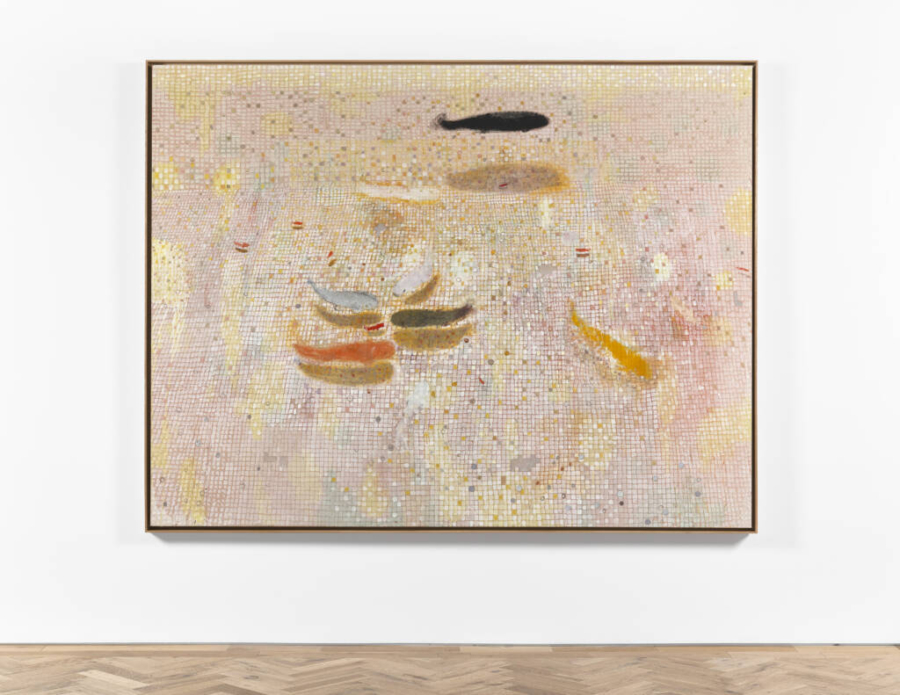January 11, 2024
Download as PDF
View on Frieze Magazine

Andrew Cranston, Why have you stopped here?, 2023. ©Andrew Cranston. On loan from a private collection. Courtesy of the artist and Ingleby, Edinburgh. Photo: John McKenzie
‘What Made You Stop Here?’ – Scottish painter Andrew Cranston’s first solo exhibition at a major public gallery – contains 38 large-scale compositions and intimate, off-kilter miniatures often painted on the linen-bound covers of second-hand books. Bringing together largely new and recent work, the show presents a world of quiet interiors and warping landscapes on the edge of the imagination – not quite dreamlike, not quite real.
Blending everyday objects and personal history with scenes prompted by wayward scraps of painting, literature, hearsay and film, Cranston’s work creates a hybrid environment, where the familiar – fried eggs, watermelons, jars of tadpoles, wheels of cheese – is balanced out by strange and unexpected moments. At times, the paintings seem like memories, already hazy and obscure, punctuated suddenly by details drifting in from other contexts – evidence, perhaps, of what Cranston, writing in a brief text to accompany his painting Clots (2022), has termed ‘creative misremembering’. As the American poet Elizabeth Bishop – whose work lends one of Cranston’s canvases its title, Questions of Travel (2023) – writes in her poem ‘Santarém’ (1978): ‘Of course I may be remembering it all wrong / after, after – how many years?’ A wide-ranging reader, Cranston’s paintings are often subtly inflected by images, scenes and objects prompted by the writing he consumes, whether newspaper reports or the nonsense poetry of Edward Lear.
The intriguing titles of Cranston’s paintings invite us to imagine a series of unreeling narratives. Why Can’t I Be You? (2022) captures a figure lying on a white shagpile carpet, an angry pimple flaring on their skin. A Broke Yolk (2021) shows a heat-struck camping trip in an Edvard Munch-like landscape, a blue shape (tidal wave? volcanic island?) rising ominously from the horizon. In A snake came to my coffee table on a hot, hot day to drink there (2023) – newly acquired by The Hepworth Wakefield – a serpent slides its way across a sunlit living room, watched by a toddler in a flimsy crib. This sense of narrative is certainly encouraged by the fact that Cranston’s scenes are often painted on old hardback books, implying their unfolding contents. Home Schooling (2020) goes a step further, clearly displaying the title on its spine, providing a possible clue to the underlying narrative suggestiveness of Cranston’s work: Scottish Short Stories (1958).
Nevertheless, these paintings provoke more questions than they offer answers, remaining stubbornly ambiguous. Like their crazily patterned carpets, curtains, wallpapers and fishpond tiles (eerily warped by invisible water), Cranston’s scenes refuse to stabilize fully, knocking themselves off balance, somehow self-disturbing. The paintings are caught between two kinds of motion, one forward – like the linear narratives they suggest – the other backwards, into memory. After all, writes Cranston alongside Craigie’s Return (2019): ‘Painting is an act of remembering and forgetting, covering and uncovering, tracing and retracing, getting lost and finding a way.’ Elsewhere, Walled Garden (after Paul Klee) (2023) shows an environment so lightly rendered that it scarcely seems to be there. Gazing into a display case, the young boy in Questions of Travel has yet to notice that his legs have turned translucent (or, perhaps, haven’t solidified), while the text accompanying Eleven Cats (2020) notes that Cranston rendered the painting over several years, ‘things added and […] things taken away’. Sure enough, we discover that the murky interior of Echoes (2021) has been bleached into existence, gently stripping back the deep, Mark Rothko-like surface of a canvas dyed by Cranston in the washing machine, a paradoxical erasure.
Best of all, the floating, blimp-like goldfish of Why Have You Stopped Here? (2023) – a nod to Henri Matisse – seem suspended in time, hovering between the past and the future, though not quite in the present, either. Both ‘beautiful and menacing’, writes Cranston, the fish exemplify the dream-adjacent world of these paintings, familiar and real but in the process of becoming strange or distorted, another ‘here’ entirely.



